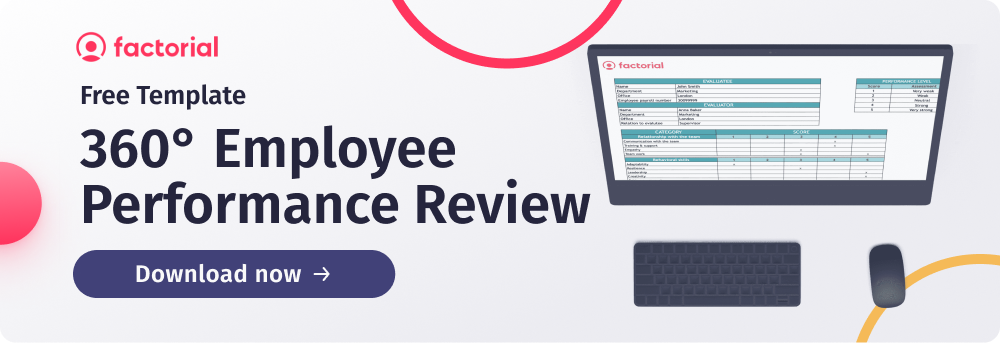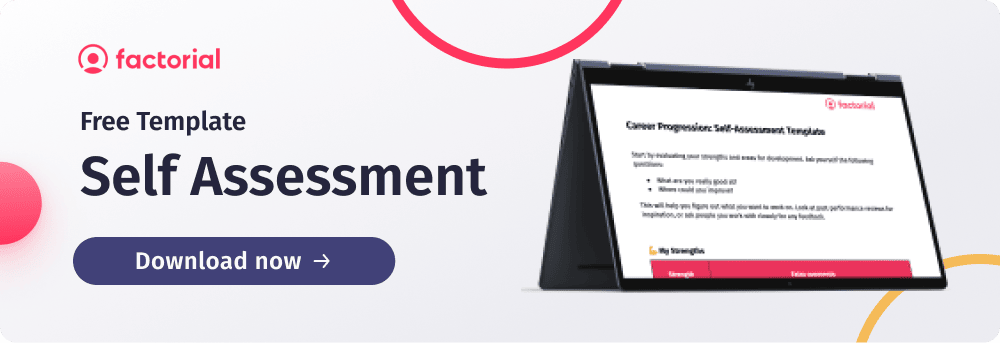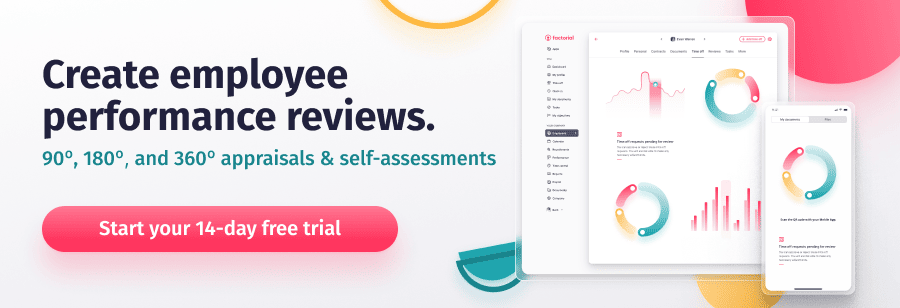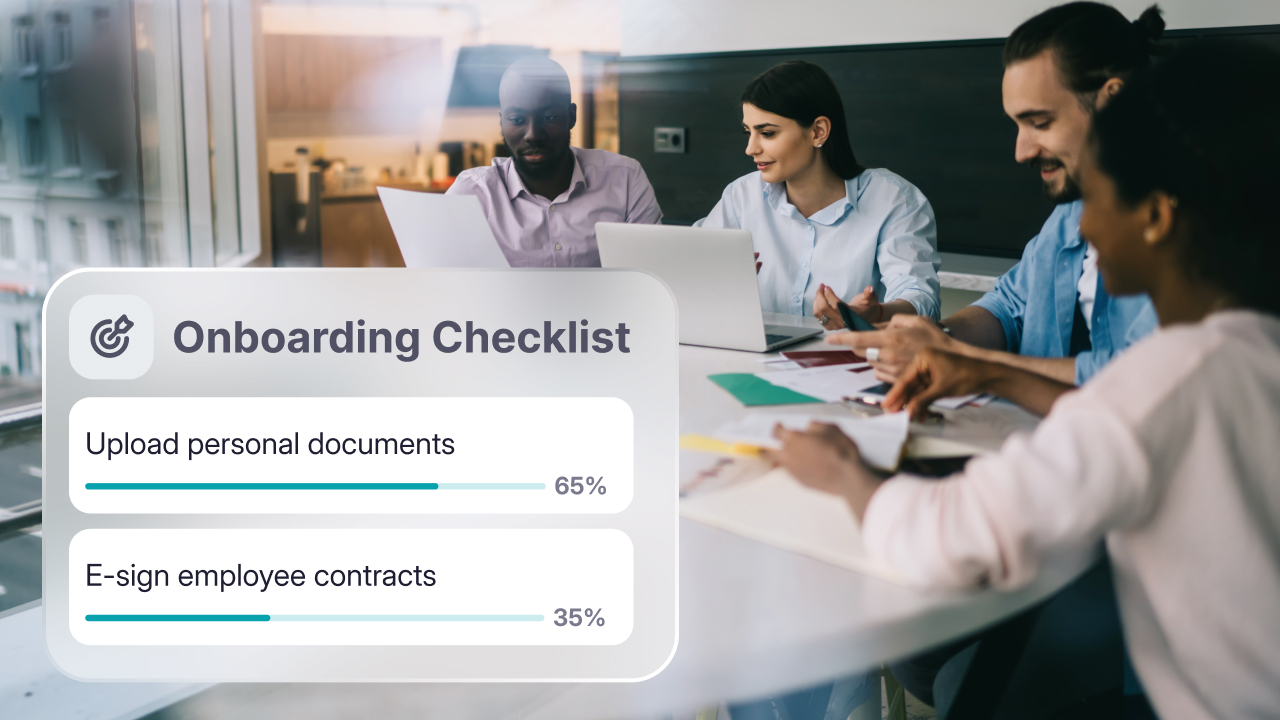A personal development review (PDR) is a process in which an employee and HR managers discuss the employee’s progress and challenges, as well as goals for the future and training opportunities.
This process allows teams to explore the skills they want to develop, set goals, and create an action plan for those goals. It is often part of a performance management cycle that helps you to understand how to improve performance from the employee side as well as from an organisational perspective.
If you’re an HR manager, you’re likely responsible for conducting personal development reviews for your employees. But what exactly is a PDR? And how can you make sure the process goes smoothly?
In this article, we’ll explore what a personal development review is, how it works and why it’s beneficial for both employees and companies.
What’s a Personal Development Review?
Personal development reviews are one of the most common ways to document and improve employee performance. They can be used to identify training needs, provide feedback on performance, and offer support for professional development.
These reviews are usually performed as formal meetings, and usually take place every month or once a year, depending on the company’s policy. But they can also be conducted on an informal basis to address regular performance issues and provide support. The biggest benefit of PDRs is that they give employees a chance to reflect on how they’re doing at work, while also giving them an opportunity to set new goals for achieving their career ambitions.
These reviews are essential for the accomplishment of the company’s goals. PDRs are a way to give career advice and coach employees to perform better at their duties. But if they are not conducted properly, chances are your reviews end up being useless from an organisational point of view. In fact, only 14% of employees strongly agree their performance reviews inspire them to improve (Source: Gallup).
It’s important that HR managers know how to run reviews effectively within an organisation. And although PDRs are carried out in different ways, there are some key steps to follow:
- State the purpose of your review: Before you start, make sure everyone agrees on what the review will achieve. Is it simply to give 360-degree feedback on performance or is it to help employees identify their strengths and weaknesses? What type of support do you want to provide?
- Plan ahead: There are several ways you can plan ahead for your review. You may choose some activities beforehand such as setting goals or discussing career aspirations with employees. If you’re going to be using a questionnaire or survey tool, have it ready before the review starts so people aren’t waiting around while you prepare it.
- Perform regular personal development reviews: It’s a common practice to conduct PDRs only once per year. But organisational readiness for change is asking for regular check-ins and accountability meetings to evaluate performance.
The goal is for both employees and managers to come away from the meeting feeling prepared to face upcoming challenges at the workplace.
The Problem With Traditional Personal Development Reviews
It’s not a secret that PDRs aren’t popular as they should be. In fact, 74% of UK employees believe traditional performance reviews are a waste of time. They even use the terms “time-consuming” and “pointless” to describe the outcomes of past appraisals. But, what’s the problem with PDRs?
Well, the reason why it’s not working is probably the structured and bureaucratic way to perform the reviews. Employees just don’t want to perform long-form annual performance check-ins because it represents a lot of work and it’s hard to establish annual goals and reflect on accomplishments. On the other hand, conducting regular reviews as part of shorter performance management cycles could be better both for employees and managers because you can work with fresh data.
Why Are PDRs Important?
PDRs help employees improve their skills, which ultimately leads to better decision-making and improved productivity. For example: if an employee has trouble delegating tasks to other workers, they might be able to learn new skills during the PDR process that will help them delegate better in the future.
HR managers should conduct PDRs regularly so that employees can continue learning throughout their careers.
A personal development review gives employees the opportunity to:
- Reflect on their achievements over the past year and identify areas for improvement.
- Discuss career aspirations and clarify goals.
- Share feedback with their manager.
- Set objectives for the coming period.
- Receive support from their manager in achieving those objectives
But it’s not only good for employees. Personal development reviews help managers to:
- Understand why workers are doing what they’re doing and whether their actions are aligned with company goals.
- Identify areas where employees need more training or support so that they can build on their current strengths and develop new skills.
- Give employees feedback about how well they’re performing on the job.
- Discover outstanding employees and plan promotions.
- Offering bonuses or higher salaries to qualified employees.
What Should Be Included in a PDR?
Performance development reviews are a way for managers and employees to discuss performance and development. They should be a regular activity of your organisation’s HR strategy.
A PDR is a chance for you to discuss an employee’s strengths, development needs, and goals. It’s an opportunity for them to tell you what they’ve been doing well, what they want to achieve and how they can improve their performance. You should also discuss any issues that might be affecting the employee’s productivity and how they can be resolved.
To conduct a successful PDR, you first need to split the process into four stages:
1. Performance Expectations
This section should include specific goals or objectives that have been set by the manager and the employee. At this point, you can review the goals established at the beginning of the performance cycle to reflect on accomplishments and obstacles in the next step.
It’s worth mentioning at this stage is helpful to judge the efficiency of the objectives you set before. Are they still relevant to your company? Were those goals realistic and aligned with the tools and skills of the employees involved? If not, then you might want to adjust your goals for the next period.
2. Performance Results
This section should include a summary of how the employee performed against their performance expectations. It should also include any feedback from other team members who may have helped with this goal or objective.
An employee’s performance should be evaluated based on the work they’ve completed within a specific period. This can be broken down into smaller tasks that are assigned to employees on a weekly basis. Some companies will include deadlines in their performance expectations, which allow employees and managers to evaluate how well an individual has performed within a cycle or period.
3. Development Plan
This section describes how the employee can increase their performance in the next period by identifying areas for improvement and providing suggestions. These plans should be based on the business objectives of your organisation and aligned with the overall direction of the company.
Furthermore, the development plan should outline the skills that need to be developed, as well as how this will be achieved.
4. Training Needs
This section should include any training that would help the employee meet their performance expectations in the future.
For example, an employee working in the sales department might state something like this in a PDR: “I want to improve my customer service skills by improving my ability to handle difficult customers”.
As a manager, it’s part of your job to search for training programs which can help the employee grow in this particular area. It’s important to provide employees with coaching and career guidance so they can develop their talents. By providing opportunities for growth and advancement, you can retain your best employees and ensure your organisation has well-trained staff to cover roles which demand more responsibilities.
94% of employees believe they would stay with a firm for a longer period if they were involved in their learning and development. (Source: LinkedIn).
After you conduct the review, you likely need to document the current state of your employee and the plans for the future. This technical document must include basic employee information such as:
- Employee’s name and job title.
- The purpose of the review (e.g., performance management).
- Any areas for improvement identified by the employee during their self-review or through feedback from others (e.g., peer review).
How to Conduct a Successful Personal Development Review
As a manager, you have a unique opportunity to help your employees improve their performance. The process of conducting a personal development review (PDR) is an excellent way to deepen your relationship with your people and help them achieve their goals.
Here are some tips for conducting a successful review:
- Set aside time with each employee: So he or she knows exactly what you’ll be talking about during the PDR session — and why this meeting matters so much to both parties involved! Be sure not to overload them with too many tasks at once; focus only on getting started with one area of improvement at a time.
- Communicate your expectations clearly: An important step of a personal development review is to communicate your expectations clearly to your employee. If you’re having trouble communicating your expectations, you can use our guide on how to create an effective performance appraisal. Before you begin your meeting with your employee, set a clear goal for what you want to achieve from the review. What do you want them to learn from this session? What do you hope they’ll achieve by the end of the period? What would be considered “best practice” if someone were conducting this assessment again?
- Gather data about your employee’s performance: Through reviews from managers and peers as well as 360-degree feedback from others in the organisation. You can also ask your employees directly what they think they need to work on, what they’re good at or what they’d like to learn more about. This information will help you tailor your discussion with each employee accordingly.
- Use performance data as part of the process: Performance data is essential for understanding where employees stand concerning their goals and objectives. By using performance data as part of the process, you can see how well an employee has. You can use this information as part of your discussion about what went well and what could be improved during the personal development review process.
- Make it a team effort: Conducting a personal development review can be a lot of work, so enlist help from other managers and leaders in your organisation. You’ll be able to cover more ground and get more feedback from people who know the employee well. You might even want to hold a group session where several people conduct interviews with whole departments at once.
- Make sure there’s enough time between reviews: An annual review should happen when an employee has been on the job for about six months or longer — otherwise, it won’t provide much value. And don’t forget to schedule regular check-ins with employees throughout the year so you can address obstacles before they become bigger problems or derail someone’s career path altogether.
How Does a PDR Impact Performance?
Many companies use PDRs as an opportunity for employees to set themselves goals for their next year of employment. This helps them to grow within their roles and become more effective at work. Besides, these reviews are a great way to keep employees engaged and retain talent, as they represent an opportunity for professional growth.
A personal development review should not be seen as a punishment or a way for management to micro-manage employees’ performance. Rather it is a chance for managers and colleagues to develop open, honest relationships with each other so that all parties can learn from team collaboration and peer review. The purpose of a PDR is to provide employees with an objective view of their performance and encourage them to identify areas for improvement. It is also used as part of the management succession planning process, as a way of identifying potential future leaders within the organisation.
How to Manage PDRs in Your Organisation
As we discussed throughout this article, personal development reviews are a crucial part of any employee’s career development and are key to promoting growth in your organisation. They allow you to get to know your employees on a deeper level, and help you understand their strengths and weaknesses, along with their training needs.
However, it can be difficult to find the time for PDRs if you’re managing multiple employees at once.
An HRIS is the best way to record employee data, such as personal development reviews and reports. With Factorial, you can keep track of all key information about your employees, including PDRs. You can also see how much time they spend at work each day or week so that you can plan projects accordingly. This will help with planning future projects and assigning tasks within the company structure, which is useful for both management and employees alike! 👉 Try Factorial for free





